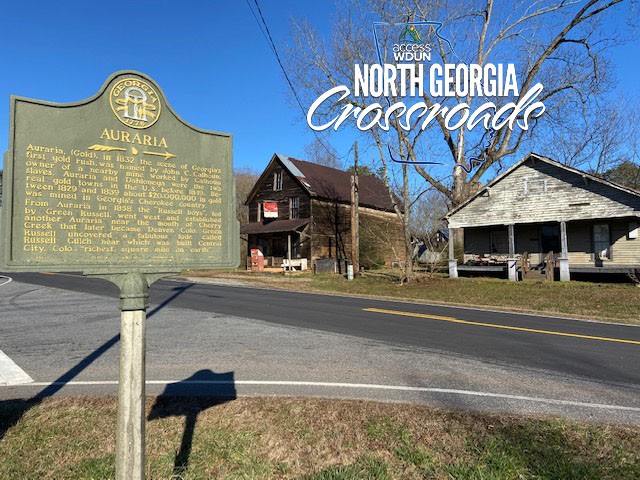If you’re driving north to Dahlonega and you decide to take the backroads, you may have passed through the community of Auraria. Some run-down buildings on the side of the road are all that is left of it, and many would never guess they represent what was once a lively and thriving community. In fact, if those buildings could talk, they would tell us that this part of Lumpkin County has a rich history.
GOLD FEVER
Auraria is where it all started – the gold rush of North Georgia. It was 1828 when gold was discovered and word spread fast. By 1829, thousands of hopeful prospectors rushed to North Georgia looking for their own treasure. Lots of communities in this area have their own “gold rush” stories, but none quite like Auraria. Auraria became the hub, the center of it all, the place where thousands of prospectors first settled, according to Chris Worick, president for the Lumpkin County Historical Society. He says that this particular gold rush was a first of its kind.
“Auraria was a phenomenon in that it was the very first boomtown- gold rush boomtown - in the whole United States. The reason it was a phenomenon is because there had never been a gold rush before,” says Worick. “This was the very first one, so it kind of took people by surprise because they didn’t know how to react to this, so it kind of grew up out of nothing, basically on the frontier of GA at this time.”
Auraria was chosen because it was situated perfectly between the Etowah and Chestatee Rivers, perfect for gold mining, and hopeful miners converged upon the peaceful foothills. As soon as the news of “gold” spread, every day the number of those arriving increased.
Worick says it’s hard to know the actual numbers, but it was a large population. “Anywhere from 1,000 up to as large as 10,000 there, so for sure, thousands of people. Now granted, miners moved around quite a bit so it was probably a transient camp of sorts where people would come and go on a very short notice. They are always chasing the next big strike, so it’s hard to say at any given time how many thousands of people might have been living there.”
As large numbers of prospectors flocked to the area, Auraria went from being a single cabin to a thriving settlement. Miners quickly, almost overnight, built an entire town.
“It grew up so fast that thousands of people were attracted to come here and it created hotels, general stores, no shortage of taverns, ten pin alleys operating day and night, so just a rowdy atmosphere, and of course mining. There was even a mining company bank that was established with the Pigeon Roost Mining Company,” says Worick.
WHAT’S IN A NAME
The town was originally called Nuckolsville – after Nathaniel Nuckolls, a local tavern owner. But many called it Knucklesville for the amount of fist fighting and rowdy behavior that took place.
The first Auraria newspaper, printed in April of 1933, talks about how Auraria eventually got its name. It’s Latin for “gold” or “yellow money” – just like the word “Dahlonega” also means the same thing in the Cherokee language.
MOVING ONWARD
Auraria was a booming community, but only for a short time. Just as quickly as the thousands of miners came, they left. First, Dahlonega became a more conducive site to build on and the county seat was moved northward in 1833, with many business owners moving to the new town. Then, in 1848 gold was discovered in California and a majority of the prospectors headed west.
WHAT REMAINS
But what was left behind were still a few families. Auraria was still a community, even if the majority of its original residents were gone. Main street remained along with a hotel, post office, school and church and a few other buildings.
In the center of town was the General Store. It remained long after all the other buildings were gone.
Lynette Woody Stowers grew up in Auraria, her family dating back to the area from the late 1800’s. “When I was a kid there was probably about 15-20 buildings there, but there’s just a couple of buildings left. There was over 400 families that lived here at one time,” she reminisces. “There was a post office, a bowling alley, a couple of taverns of course, and a general store. And upstairs in the general store, where my mom owned, in the early days, there was a clothing store upstairs.”
Her family, the Woodys, bought the general store in the 1950’s and Lynette remembers fondly the days when Woody’s General Store was thriving and the heart of the community.
“In the 50’s and 60’s and 70’s, the store was booming. When my mom and dad bought the store, my dad liked pin ball machines, so they put a pin ball machine in there,” Stowers recalls fondly. “They had a juke box and young people would come on Saturday nights and sing and dance. It was just a good, clean, fun place. No drinking, nothing like that going on. It was just a good, clean place to go. They had all the produce, meats, everything that you would have in a big store, but just on a smaller scale.”
Kate Woody kept the store open until 1997, running it for over 45 years. In fact, the intersection at Auraria is named after her, as she was an important part of the community. The longtime residents of Auraria still remember when the general store was a welcoming place for neighbors to gather.
“In the summertime, we had two big benches and people would congregate on the benches and you know that was just a chat place. And in the wintertime there was a big old pot-bellied stove right in the center of the store and people would congregate around it and my mother always had a pot of coffee made,” remembers Stowers.
FORGOTTEN PAST
Once the general store closed, there wasn’t much left of Auraria. In fact, the Woody family sold it last year to a new owner. There are talks that he may restore it, and those who remember it in its prime are hopeful, but many others now call Auraria a “ghost town.” It’s true; the run-down buildings are symbolic, as much of its history is being lost.
Worick says it’s hard to see so many important, historical buildings, and their bygone stories, in disrepair. “It’s one of these hidden treasures that has been so overlooked,” he says. “It’s been talked about, but it’s like a lot of things, it’s being forgotten, sadly, because people don’t really have a sense of history anymore, so these things are getting forgotten and overgrown and we might just have nothing more than just a historical marker to mark where this treasure in the Georgia mountains is located at some point. But hopefully we have some people who want to take this on and keep this memory alive.”









